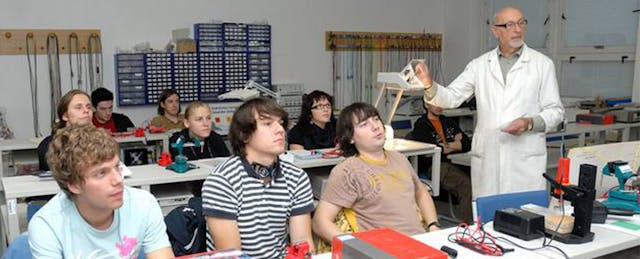Lily Mohamed works in avionics for Sikorsky Aircraft Corp., crediting the mentoring and technical skills she learned at Connecticut’s Platt Technical High School.
Alexis Smith is studying biomedical engineering at the University of Toledo, thanks, she says, to her high school years at the Toledo Technology Academy. The career and technology education (CTE) program “opened up the doors of opportunity for me.”
Nicholas Pinchuk, chairman and CEO of Snap-on Tools, says CTE “is the single best weapon” companies have in today’s global competition for jobs.
Teachers in Connecticut’s Technical High School System take advantage of externship opportunities for professional development that allow them to observe and participate in the workplace and gain valuable insights into the academic, technical and interpersonal skills required. These kinds of experiences help teachers make their lessons and curricula richer, more relevant and more aligned to the careers of today and tomorrow. CTE is no longer your father’s shop class. Vocational ed is out; CTE is in.
What’s the difference?
Last century’s vocational programs offered old-fashioned woodworking and auto mechanics, providing good skills but also tracking students for jobs right out of high school. Today, CTE provides a vastly different pathway, one that leads to high school graduation, higher education and meaningful middle-class, 21st-century jobs in skilled trades, applied sciences and technology. The idea is to prepare students for a career at whatever point they decide to pursue one and to align high school CTE with postsecondary options. Curricula have changed even in woodworking, where today’s students learn to read blueprints, make detailed drawings and use machinery commonly used in a very different woodworking industry. Similarly, automotive careers have adapted to a changing industry where computerized equipment, electronics and advanced materials are now standard, and students can choose to study fuel cells or electric car design.
I have visited many remarkable CTE programs, and the most effective ones have well-prepared educators who have externship opportunities for targeted professional development; partnerships with businesses that provide students with authentic work opportunities (both as internships during high school and full-time jobs after graduation); and a strong relationship between the technical fields and academic subjects like English, history, science and math.
With a CTE program, a student who might otherwise have wondered about the value of school can see a direct connection between graduation and a good job. In the United States, 3 out of 4 students graduate from high school on time. For those in CTE programs, 9 out of 10 graduate on time, with 7 of every 10 enrolling in postsecondary education. And CTE translates into earning power. Since 1993, the research group MDRC has compared earnings of young men who graduated from career academies and traditional high schools. Eight years out of high school, career academy graduates earn, on average, 16 percent more than their traditional high school peers.
As Pinchuk and other business leaders would attest, employers are looking to recruit people with a strong knowledge base, technical skills, and critical-thinking and problem-solving abilities. And their go-to job pool includes CTE graduates.
Alexis’ alma mater, Toledo Technology Academy, is a magnet school focused on engineering and related technologies, established through a labor-management partnership. One of the school’s partners is the United Auto Workers.
In New York City, Pathways in Technology Early College High School, or P-Tech, partners with IBM and the City College of New York. It offers a science, technology, engineering and math curriculum leading to a high school diploma and an associate degree. Every student has an IBM mentor and access to a paid internship with the company. Another impressive New York program is offered at Thomas A. Edison Career and Technical Education High School, featuring programs in automotive technology, graphic arts and robotics.
At this time of tremendous partisanship and gridlock in Washington, CTE is something that should cross political divides. Congress should reauthorize the Carl D. Perkins Career and Technical Education Act with full funding and support a bipartisan bill to improve the quality of, and access to, CTE programs.
CTE is an investment, allowing students to learn and preparing them for good jobs. Scaling successful programs so that as many students as possible can take advantage of them and move on to successful careers is the next hurdle.


